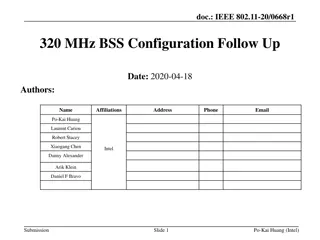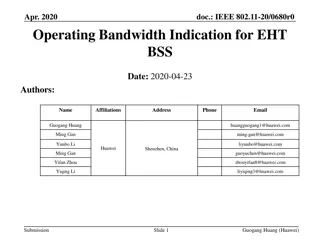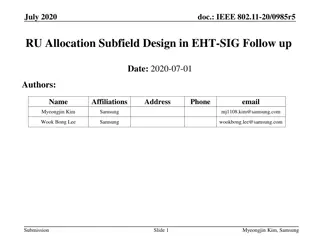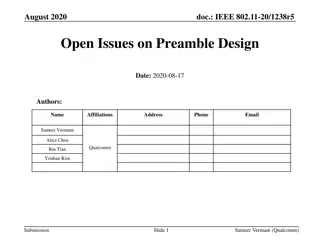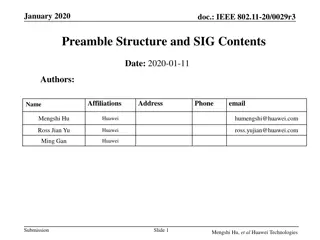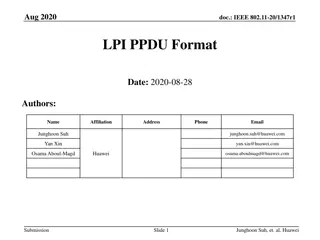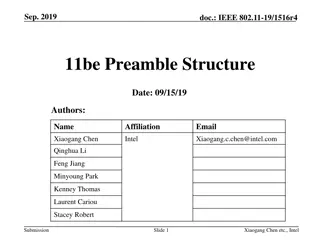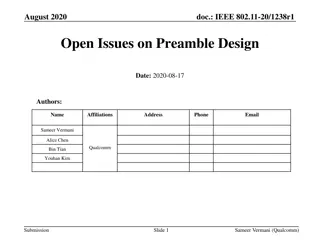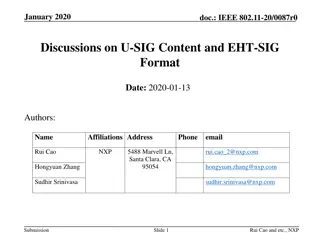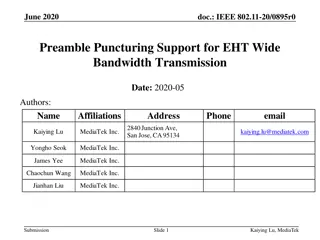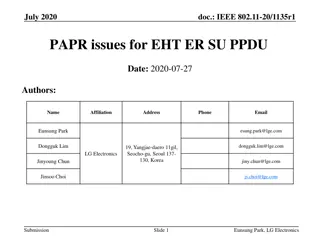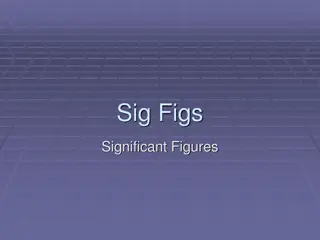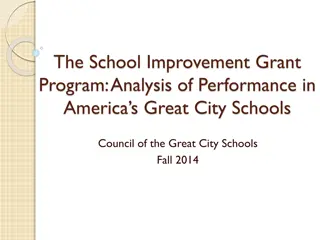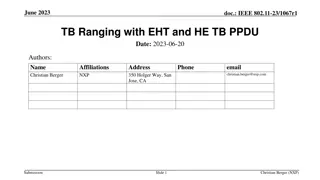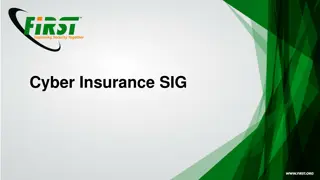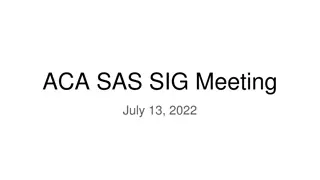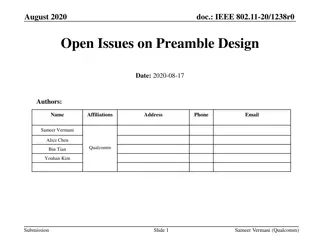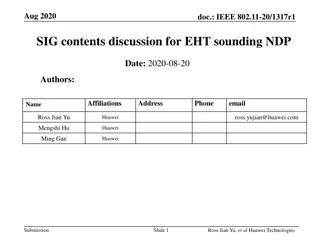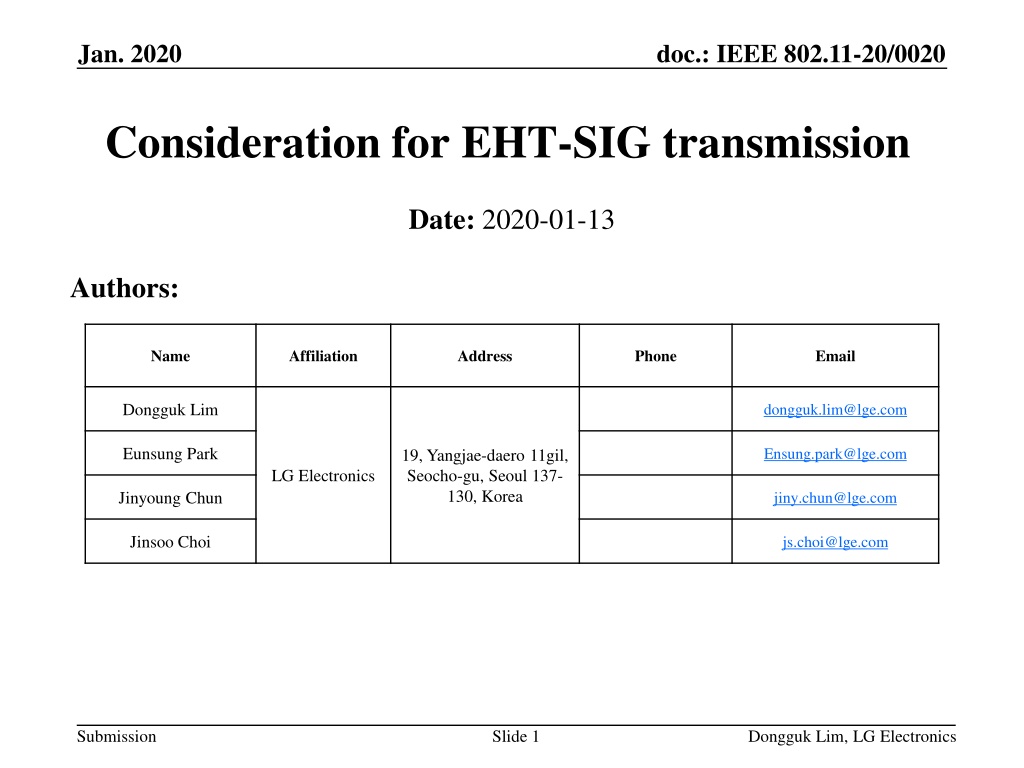
Flexible Options for EHT-SIG Transmission in IEEE 802.11-20/0020 Document
Explore the considerations for EHT-SIG transmission in the IEEE 802.11-20/0020 document, focusing on enhancing spectral efficiency with flexible preamble puncturing and reducing signaling overhead. Discuss options for EHT-SIG content channel, BW, STA capability, and signaling overhead calculations.
Download Presentation

Please find below an Image/Link to download the presentation.
The content on the website is provided AS IS for your information and personal use only. It may not be sold, licensed, or shared on other websites without obtaining consent from the author. Download presentation by click this link. If you encounter any issues during the download, it is possible that the publisher has removed the file from their server.
E N D
Presentation Transcript
Jan. 2020 doc.: IEEE 802.11-20/0020 Consideration for EHT-SIG transmission Date: 2020-01-13 Authors: Name Affiliation Address Phone Email Dongguk Lim dongguk.lim@lge.com Eunsung Park Ensung.park@lge.com 19, Yangjae-daero 11gil, Seocho-gu, Seoul 137- 130, Korea LG Electronics Jinyoung Chun jiny.chun@lge.com Jinsoo Choi js.choi@lge.com Submission Slide 1 Dongguk Lim, LG Electronics
Jan. 2020 doc.: IEEE 802.11-20/0020 Introduction Inthe previous meeting, for the enhancement of spectral efficiency, we agreed that EHT supports the preamble puncturing mechanism. It was not determined yet, but various patterns and the large size of unit(i.e., 40MHz) for puncturing were discussed. And, some of options considering the preamble puncturing for EHT-SIG content channel were introduced in [1]. Where in, the preamble pattern as in 11ax was considered. In this contribution, we discuss the EHT-SIG content channel options for supporting of flexible preamble puncturing and reduction of signaling overhead. Submission Slide 2 Dongguk Lim, LG Electronics
Jan. 2020 doc.: IEEE 802.11-20/0020 BW and STA capability As described in [2], to support the high throughput, EHT will mainly use the wide bandwidth such as 160MHz, 240MHz, and 320MHz in 6GHz band. Channelization of 6GHz UNII5 UNII6 UNII7 UNII8 Band(GHz) 5.925-6.425 (500MHZ) 6.425-6.525 ( 100MHz) 6.525-6.875 (350MHz) 6.875-7.125 (250MHz) Also, to protect the incumbent STA that operates in 6GHz band, the various preamble puncturing patterns may be considered. The 40MHz size of puncturing was considered to accommodate 30MHz incumbent link in [3] And, to utilize the wide bandwidth efficiently, EHT STA may have the enhanced receiver capability to support the decoding of the signal field which is transmitted through on the BW larger than 80MHz. We can take into account for the decoding of the HE-SIGB transmitted through on 160MHz. We will consider the three options for EHT-SIG transmission by taking into account enhanced STA capability and various preamble puncturing patterns. Submission Slide 3 Dongguk Lim, LG Electronics
Jan. 2020 doc.: IEEE 802.11-20/0020 EHT-SIG content channel We can consider the following three options for EHT-SIG content channel. Option 1 (1,2,1,2,1,2,1,2) : same with 11ax 1 2 1 2 1 2 1 2 1 2 1 2 1 2 1 2 40MHz 320MHz Option 2 (1,2,1,2,3,4,3,4) : duplicating the EHT-SIG information per 40MHz in each 80MHz separately, with different EHT-SIG information in each 20MHz within 40MHz. 1 2 1 2 3 4 3 4 1 2 1 2 3 4 3 4 40MHz 320MHz Option 3 (1,2,3,4,1,2,3,4) : duplicating EHT-SIG information per 80MHz, with different EHT-SIG information in each 20MHz within 80MHz 1 2 3 4 1 2 3 4 1 2 3 4 1 2 3 4 80MHz 320MHz Submission Slide 4 Dongguk Lim, LG Electronics
Jan. 2020 doc.: IEEE 802.11-20/0020 Signaling overhead For the calculation of signaling overhead, we assume the followings. Same contents as in HE-SIGB. Number of bits for Common field 8 N* + 1 + CRC(4) + tail(6) Number of bits for User specific field 21 n**+ CRC(4) + tail(6) MCS of EHT-SIG: MCS0 RU allocation in 20MHz (number of RU, size of RU): (9, 26) Considering the worst case that has max signaling overhead Bandwidth : 160MHz and 320MHz The number of symbols for EHT-SIG Option 1 Option 2 Option 3 160MHz 74 (296us) 38(152us) 38(152us) 320MHz 147(588us) 74(296us) 74(296us) Note that the number of symbols for EHT-SIG can be reduced by assuming higher MCSs or less users. As shown in the above results, option 1 has a twice signaling overhead than other cases. Since the signaling overhead of multiple STAs is distributed into 4 contents channel, option 2 and option3 have smaller overhead than option1. * N: number of RU allocation field in HE-SIGB content channel, ** n : number of user field in user block field Submission Slide 5 Dongguk Lim, LG Electronics
Jan. 2020 doc.: IEEE 802.11-20/0020 Consideration for puncturing pattern(1/2) Unlike supporting of limited puncturing patterns in 11ax, various puncturing patterns based on 20MHz can be considered in 11be due to the enhancement of STA capability. For example, we can support the [1 0 0 0], [1 0 1 0], and [1 0 0 1] configurations in 80MHz for 160MHz operating mode device Where in, Primary 20 is assumed as the first 20MHz channel Also, for the protection of the incumbent link (ex., 30MHz in [3]), we can consider the 40MHz size of puncturing cases as wall as 20MHz size of puncturing cases. The 40MHz size of puncturing can be considered in primary 80/primary 160. For example, the punctured 40MHz is located in 160MHz as following P20 Punctured P20 P20 160MHz And, we may further take into account larger size of puncturing than 40MHz if there are incumbent links larger than 40MHz or not use the aligned channelization in 6GHz. P20 160MHz Submission Slide 6 Dongguk Lim, LG Electronics
Jan. 2020 doc.: IEEE 802.11-20/0020 Consideration for puncturing pattern(2/2) In [3][4], for the efficient utilization of BW, the various large-RU combinations were introduced in 11be. It assumed the large-RU size is configured based on 20MHz (i.e., RU 242). So, for the consistent operation with multiple RUs, the preamble puncturing pattern can be designed by considering the multiple RU combinations. For example, we may take into account following multiple RU combinations as the puncturing patterns in 160MHz. Possible transmission BW RU in one 80MHz RU in another 80MHz 100MHz 242 996 120MHz 484 996 120MHz 242+242* 996 120MHz 484+242** 484+242 140MHz 242+484 996 *: non-continuous combination is considered, ** : both continuous and non-continuous combinations are considered Submission Slide 7 Dongguk Lim, LG Electronics
Jan. 2020 doc.: IEEE 802.11-20/0020 Preamble puncturing in 320MHz (option 1) 1 2 1 2 1 2 1 2 1 2 1 2 1 2 1 2 40MHz 320MHz EHT-SIG content channel is configured as same as HE-SIGB content channel. And, since the two content channels are used, the transmission on wide bandwidth incurs large signaling overhead. This content channel design is able to be applied both 80MHz and 160MHz that STAs are capable to receive EHT-SIG. It is possible to support the preamble puncturing in wide bandwidth by using the extension of the preamble puncturing pattern defined in 11ax. However, due to the limited puncturing pattern in P80, it is difficult to support some of the patterns described in slide 6 and 7. Submission Slide 8 Dongguk Lim, LG Electronics
Jan. 2020 doc.: IEEE 802.11-20/0020 Preamble puncturing in 320MHz (option 2) 1 2 1 2 3 4 3 4 1 2 1 2 3 4 3 4 40MHz 320MHz Four content channels are used for EHT-SIG transmission in 320MHz The two different content channels are included in each 80MHz within 160MHz. So, It has low signaling overhead because the information for EHT-SIG is distributed to four content channels. And, since the receiver should decode the two content channels in each 80MHz within 160MHz, in 320MHz, there is some restriction to support the flexible puncturing pattern and the reception of 160MHz for EHT-SIG is demanded. Also, it is difficult to support the non-continuous 240MHz such as 80+160 in 320MHz because STA can t decode the content channel 3 and 4 even though STA has a capability for decoding 160MHz for EHT-SIG. Submission Slide 9 Dongguk Lim, LG Electronics
Jan. 2020 doc.: IEEE 802.11-20/0020 Preamble puncturing in 320MHz (option 3) 1 2 3 4 1 2 3 4 1 2 3 4 1 2 3 4 80MHz 320MHz The four different content channels are used in 80MHz and these channels are duplicated per 80MHz. Due to the distribution of information for EHT-SIG into the four channels, it can have low signaling overhead. This design can be applied to the reception of EHT-SIG through 80MHz and 160MHz. While it is difficult to support a flexible preamble puncturing in 80MHz EHT- SIG reception as in [1], we can relax the restriction with wide BW EHT-SIG reception, e.g. 160MHz. The receiver can get the information of punctured 20MHz channel in an 80MHz by using the 20MHz content channel which has the same information in another 80MHz. It is also able to support the various patterns of non-continuous 240MHz in 320MHz because of duplication of SIG content channels per 80MHz. Submission Slide 10 Dongguk Lim, LG Electronics
Jan. 2020 doc.: IEEE 802.11-20/0020 Indication of puncturing In 11ax, STA can know the preamble puncturing pattern by using the BW field in HE-SIGA and RU allocation field in HE-SIGB. We can take into account a similar way with 11ax regardless of options for EHT-SIG configuration. We think that it is a simple way to indicate the puncturing pattern without increasing complexity. So, preamble puncturing can be indicated by using the BW field in U- SIG and pattern information in EHT-SIG. For example, BW and pattern information for preamble puncturing can be consisted of as following BW field The bits assigned for this can be equal to or more than 4 bits. 20MHz / 40MHz / 80MHz (non-punctured) / 160MHz (non-punctured) / 240MHz (non-punctured) / 320MHz (non-punctured) / 80MHz (punctured) / 160MHz (punctured) / 240MHz (punctured) / 320MHz (punctured) Details for punctured BW are TBD. Pattern information For this information, we can consider the RU allocation field which is defined in 11ax or other information bits that is configured differently. Submission Slide 11 Dongguk Lim, LG Electronics
Jan. 2020 doc.: IEEE 802.11-20/0020 Conclusion We investigated the three options for configuration of EHT- SIG by considering various aspects. In terms of overhead, option 2 and option 3 seem better choice than option 1 For supporting various puncturing or large-RU patterns, option 1 and option 3 have more flexibility. Since it is demanded to receive two different content channels in each 80MHz within 160MHz, option 2 has some restricted flexibility. Overall, option 3 can be a reasonable approach, particularly for a wide bandwidth ( 160MHz) transmission. Option 1 can be still considerable if the overhead is not a critical issue For the indication of puncturing, we can consider the similar way of signaling as in 11ax. The BW field and information for puncturing pattern can be used for indication of preamble puncturing in 11be. Submission Slide 12 Dongguk Lim, LG Electronics
Jan. 2020 doc.: IEEE 802.11-20/0020 Straw poll 1 Do you agree that 11be supports a capability of EHT- SIG reception by more than 80MHz? The configuration of EHT-SIG content channel is TBD. Y/N/A Submission Slide 13 Dongguk Lim, LG Electronics
Jan. 2020 doc.: IEEE 802.11-20/0020 Straw poll 2 Do you agree that in large BW transmission ( 160MHz), EHT-SIG content channels are configured as option 3 described in slide 10? 1 2 3 4 1 2 3 4 1 2 3 4 1 2 3 4 80MHz 320MHz Duplicating EHT-SIG information per 80MHz, with different EHT-SIG information in each 20MHz within 80MHz. Y/N/A Submission Slide 14 Dongguk Lim, LG Electronics
Jan. 2020 doc.: IEEE 802.11-20/0020 Straw poll 3 Do you agree that the EHT-SIG content channel consists of the same configuration defined in 11ax? Y/N/A Submission Slide 15 Dongguk Lim, LG Electronics
Jan. 2020 doc.: IEEE 802.11-20/0020 Straw poll 4 Do you agree that the preamble puncturing can be indicated by using the BW field and puncturing pattern field? The details on configuration for the preamble puncturing are TBD. Y/N/A Submission Slide 16 Dongguk Lim, LG Electronics
Jan. 2020 doc.: IEEE 802.11-20/0020 Reference [1] 11-19/1606r0, Preamble Puncturing and SIG-B Signaling [2] 11-18/1231r6, eht-draft-proposed-par [3] 11-19/1908r0, Multi-RU Support [4] 12-19/1907r0, Multiple RU Combinations for EHT Submission Slide 17 Dongguk Lim, LG Electronics


